Gran Turismo 7 has been updated to take advantage of the PlayStation 5 Pro, and everyone wants to know: how does it improve the game — and is it worth it?
To answer those questions, I have spent the past few days analyzing the game on the new console with both a flat-screen and with PSVR2. The PS5 Pro essentially brings more graphical settings, giving you more control over how the game looks and performs. Although you will see side-by-side screenshots in the article below, this review will best be experienced watching the video above so you can see for yourself exactly what these various features actually look like.
PlayStation Spectral Super Resolution (PSSR)

The Pro console’s new “PlayStation Spectral Super Resolution” feature, or PSSR, is basically an AI-powered image upscaler, and it has received a lot of hype as one of the PS5 Pro’s marquee features.
It renders the game at a lower resolution internally, so it can maintain higher frame rates while showing more effects. Then, it uses AI algorithms to upscale each frame to 4K resolution, allowing the console to — in theory — combine maximum visual effects with high image fidelity.
However, as the famous quote states, “there ain’t no such thing as a free lunch”, and PSSR is no exception to that rule.
First, let’s talk about the positives.
Enabling PSSR in Gran Turismo 7 offers a significant upgrade to the game’s lighting and texture details, particularly in cars’ interior views. The way the light interacts with interior surfaces is more natural and realistic thanks to real-time ray-tracing. There are some very impressive details which might be hard to notice at first, but when you put the footage side-by-side, the improvements are nothing short of remarkable.
Low-light scenes, in particular, see the most benefit.
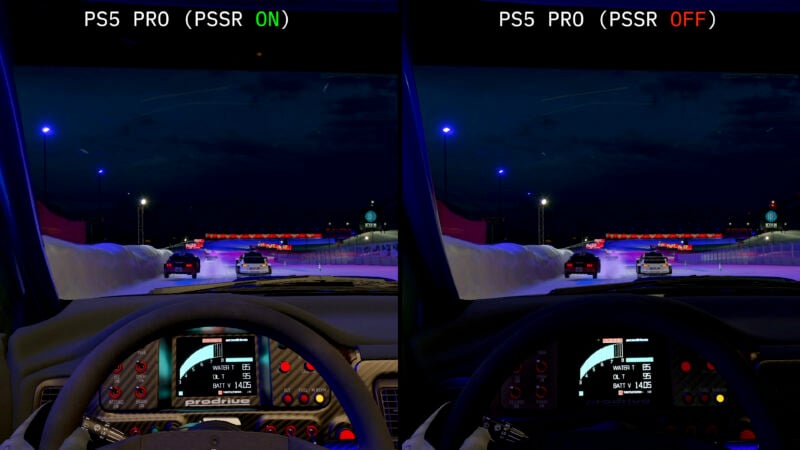
An example of this can be seen in the ‘98 Subaru Impreza Rally Car driven at the snowy Lake Louise circuit at dusk. As you can see here, with PSSR disabled, the steering wheel and dashboard appear as featureless, black surfaces. Compare this to the PSSR-enabled image, which reveals the carbon fiber weave on the dashboard, the texture of the steering wheel, and labels on the buttons.
Even more impressive: look at the reflections of the digital gauge cluster as it reflects off the sides of its enclosure. That’s a real-time effect, which changes in brightness and intensity as the light from the tachometer grows.
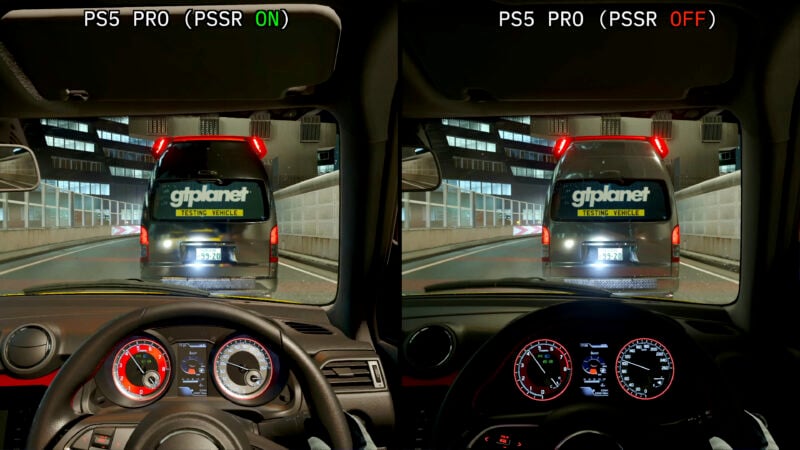
Another example comes from interior footage at Tokyo Expressway. This is an excellent testing track because there are so many different light sources around the environment that should be interacting with the interior of the car. Upon entering the tunnel, we can see the dashboard is flooded with reflections as the car passes under each light on the ceiling above. It’s a dramatic effect, and very realistic. When viewed side-by-side, the non-PSSR footage, which is also what you would see on a standard PS5, looks dull and flat by comparison.
Having said all of this, however, the benefits of PSSR are less obvious outside of the car. This is where we start to find some of its downsides as well.
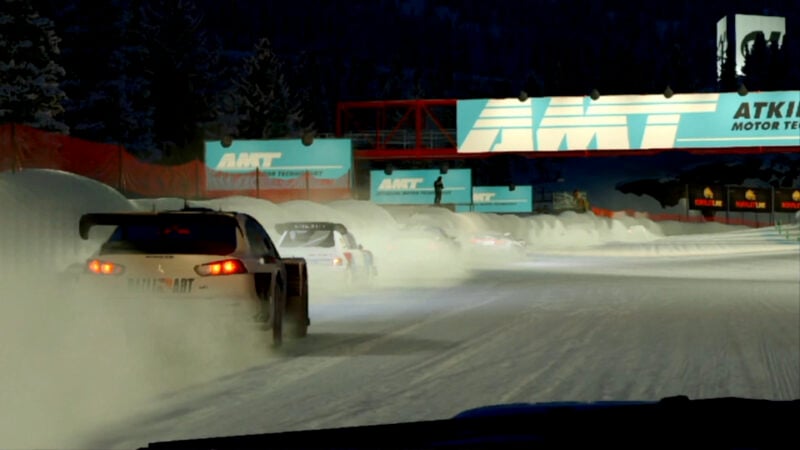
Looking at the same footage from the Lake Louise snow circuit, we can see the fidelity of particle effects have been compromised. At certain points around the track, the clouds of snow turn into shimmering, lumpy blobs, looking similar to the often-criticized smoke effects seen back in Gran Turismo 5. During full-screen gameplay, I found it to be an ugly distraction any time particle effects were visible.
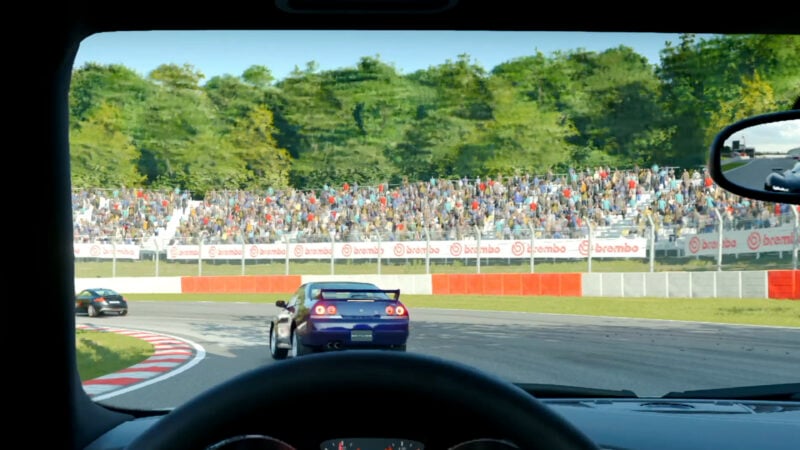
Another issue appears with trackside trees, where the PSSR algorithm appears to struggle upscaling the texture of the leaves. You can see this here through the first turn of Deep Forest, as the trees on the hillside turn into a smudgy mess as the image begins to pan. Although such background detail is not something you would typically be looking at, it is strange enough to grab your attention as a small reminder of PSSR’s limitations.
PSSR also seemed to regularly trigger more frame rate issues in Gran Turismo 7. The demands of real-time ray-tracing in challenging scenes with lots of cars together in complex surroundings appears to be just a bit too much for even the PS5 Pro to handle.
Lastly, although PSSR displays an image which has been upscaled to 4K, there is still a softness to the picture evident to my eyes. You probably won’t be able to see a difference in footage on YouTube, but disabling PSSR returns a crispness to the TV that reminds you what a true 4K image is supposed to look like.
Personally, I would recommend using PSSR if you typically play GT7 using interior view so you can enjoy those amazing ray-traced lighting effects. Otherwise, with the impact on frame rates, the visual artifacts with particle effects and trees, and the overall softening of the image, I’m not sure the benefits make the feature worth it.
PS5 vs. PS5 Pro
Looking beyond PSSR, it’s worth investigating what other improvements the PS5 Pro brings to the table over the standard PS5 for GT7 in flat screen mode. The answer is: not much.
There are no clear differences between the consoles when PSSR is disabled on the PS5 Pro. The only obvious change is real-time ray-traced reflections of cars, as you can see here on the side of this Lamborghini Urus. However, from what I have seen so far, ray-tracing does not appear to have been extended to other areas of the environment with PSSR disabled.
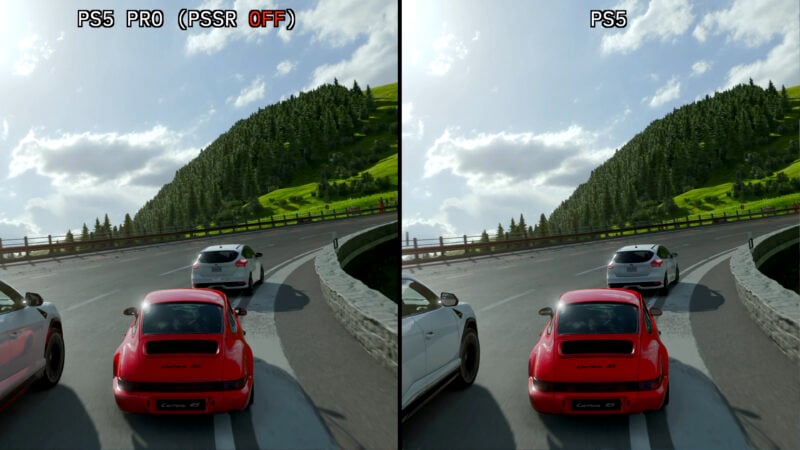
Although I know it’s not visible in captured footage or screenshots, to my eye, there does seem to be an extra bit of sharpness from the output of the PS5 Pro. If I had to guess, it’s rendering the game at a higher native resolution than the standard PS5. This also might explain why I noticed more dropped frame rates playing on the Pro with GT7’s “Prioritize Ray Tracing/Resolution” mode enabled, but without any hard data to back it up, this is speculation on my part.
This would be a good time to mention the PS5 Pro and Gran Turismo 7 now support 8K screens, but I don’t have an 8K TV or capturing device so that’s not something I can test. Presumably, the game will also run better at 120Hz on the Pro compared to the standard console, but that is also not something I have the capability of testing or sharing with you for this review.
PlayStation VR2 on PS5 Pro

As the most technologically demanding way to play Gran Turismo 7, you would expect the PSVR2 to benefit the most from the extra horsepower of the PS5 Pro. It does, but the differences are hard to demonstrate.
Remember that any PSVR2 footage you watch on YouTube or a regular screen does not come close to capturing what the experience is actually like. As a result, you won’t see much of a difference in these screenshots. You’ll just have to take my word for it that it looks different in the headset — there’s just no way to capture it.
PSSR is also only available for traditional flat screens and cannot be enabled when using VR. Instead, the game offers a different option for PS5 Pro VR users called “VR Positional Reprojection”.
The feature is not well documented and exactly how it works is beyond the scope of this review, but to put it simply, it improves the frame rate inside the headset — and in VR, that’s a really big deal.
It made the game more comfortable to use in VR for me, and it felt like I could use the headset for longer sessions between breaks. In this mode it also feels like image quality is improved, as if the headset has somehow become brighter and the 3D effects are more deep and realistic. It’s hard to describe, but I definitely prefer it.
These improvements come at a cost, though.
Because the console is “reprojecting” — or guessing — what some frames will look like, there are instances where you can see significant “artifacts”, or errors, in the image. These artifacts are a blockiness in specific areas of the scene, similar to what you might see in a low-bitrate video on a slow internet connection. I found it to be most noticeable around edges that featured a high degree of contrast, or a small section of the frame that featured a lot of movement.

For example, while recording a specific bit of footage with the Mercedes W196R, I noticed artifacts around the edge of the wooden steering wheel and in the small moving parts on the other cars. It is not visible at all in this captured output, which is supposed to be a direct feed of what is visible in the right eye piece of the headset. This suggests the positional reprojection is processed downstream from the image produced by the game, closer to the headset hardware itself.
I have to admit that although I was initially underwhelmed, my impressions of PSVR2 on the PS5 Pro began to change over the course of putting this review together.
Initially, I filmed the standard PS5 footage for this video first, then moved on to the PS5 Pro. However, after two days playing exclusively on the new console, I realized I needed more footage from the standard PS5. So, I reconnected the old console and… was met with quite a surprise.
Immediately, I noticed a softness to the image. In particular, distant details a few hundred meters in front of the car now appeared blurry and muddled, as if my eyes were having a hard time focusing. The whole experience, in general, was just not as comfortable or convincing.
I was not expecting this, but I realized the PS5 Pro and its Positional Reprojection had already spoiled me to the point where I can confidently say I do not want to go back to using PSVR2 on the standard PS5.
Of course, it’s worth mentioning this is the first upgrade to Gran Turismo 7’s VR functionality since support for PSVR2 was introduced back in 2023. It is a welcome addition, but many PSVR2 users — myself included — would like to see Polyphony Digital pay more attention to the game’s VR features.
PS5 Pro: Worth It for GT7?

For most Gran Turismo 7 players, the PS5 Pro is a tough sell. The game already runs very well on the standard PS5.
Ultimately, it comes down to a few things to consider. If you play GT7 on a TV, typically use interior view, and are willing to put up with a few strange visual artefacts and a slightly softer picture quality, the PS5 Pro is something you should consider. Otherwise, unless you just want to know you’re getting the best image quality possible, there is no real reason to go with the newer and more expensive console.
For PSVR2 users, however, there is a much more compelling reason to consider the Pro.
GT7’s VR Positional Reprojection feature is a legitimate upgrade that makes the headset even more enjoyable to use. The frame rate improvements allow me to play longer without VR fatigue or discomfort, and the improved resolution of distant objects almost makes it feel as if the headset’s hardware itself received a minor upgrade.
Does any of that make the PS5 Pro worth the extra cost?
For the vast majority of people, no, I don’t think so. This is certainly not the generational leap that you see between the PS4 and PS5. My advice is: unless you can point to a specific reason you want to upgrade, your money is probably better spent elsewhere.
See more articles on PlayStation 5 Pro.










